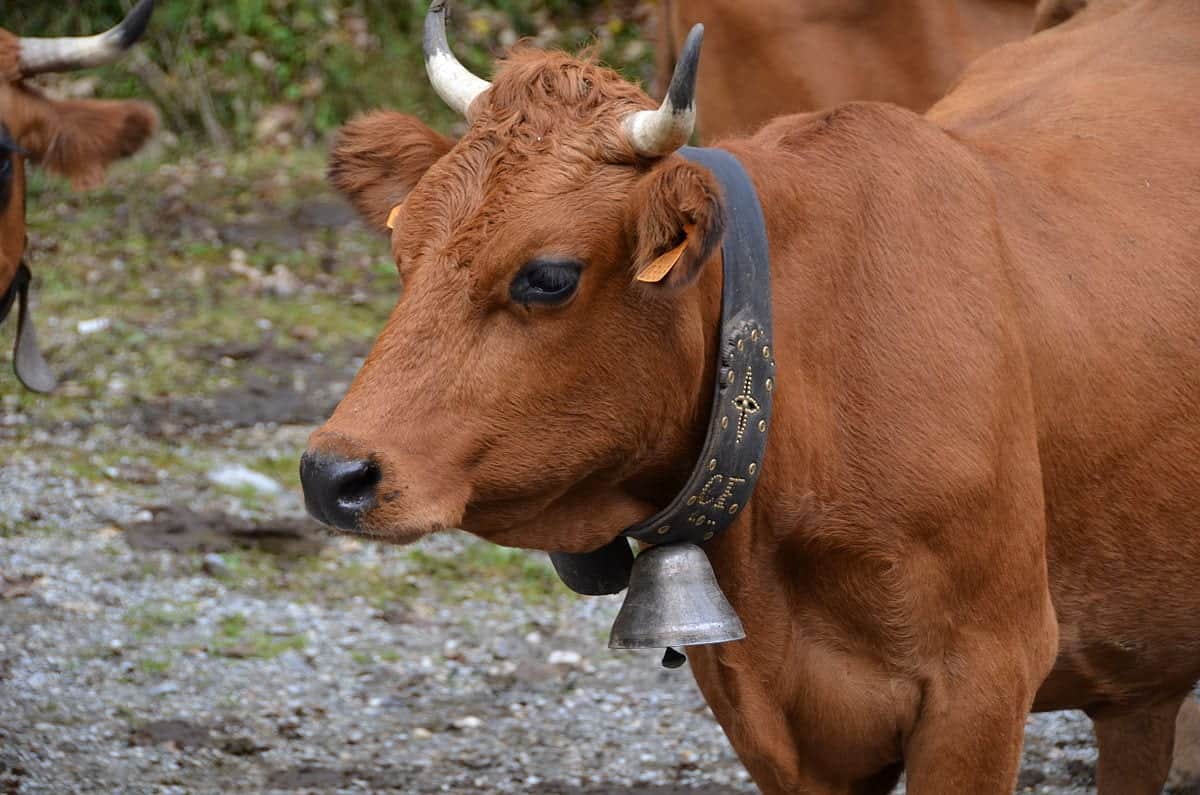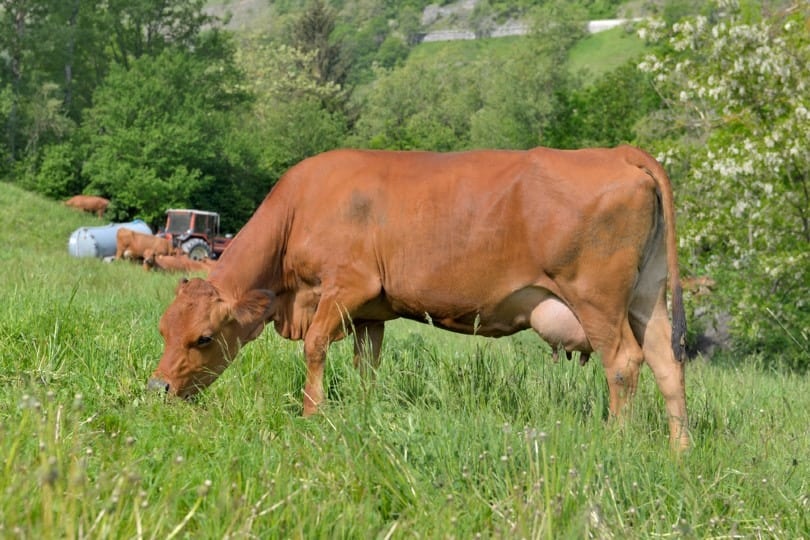Although Tarentaise cattle were only introduced to the U.S.A. in the 1970s, making them a relatively new breed to Americans, they’ve been around since the middle of the 19th century. Their highly adaptable natures make them a firm favorite for many farms around the world, even in dry, arid regions, like the Sahara Desert in North Africa.
Sturdy and resilient, the breed is easy to care for and is renowned for their milk production and delicious meat. Dairy and beef aren’t the only good things about this breed, though, and this guide will introduce you to everything you need to know.

Quick Facts About Tarentaise Cattle

| Breed Name: | Tarentaise |
| Place of Origin: | France |
| Uses: | Dairy Meat (outside of France) |
| Bull (Male) Size: | 1,600–2,100 pounds |
| Cow (Female) Size: | 900–1,300 pounds |
| Color: | Wheat, tan, or reddish-brown |
| Lifespan: | 10–12 years |
| Climate Tolerance: | Highly adaptable |
| Care Level: | Low |
| Milk Production: | 10,000 pounds High protein and butterfat |
Tarentaise Cattle Origins
In 1857, a cattle breed known as the Savoyarde was introduced during a county fair in Mont Brison. They were so-called due to originating in the Savoie region of France. It wasn’t until 1861, when the Savoie Duchy was reintegrated into France, that the breed’s name was changed to Tarentaise. Their name comes from the Tarentaise Valley below the mountains where they were first raised.
While other French breeds, like the Limousin, are raised in lush, basin regions, the Tarentaise is still kept in the mountains. They’re the only cattle breed that is sturdy enough to handle the terrain.
Tarentaise Cattle Characteristics
This cattle breed was first raised on the slopes of the Alps above the Tarentaise Valley, their namesake. The region is known for its steep gradients, rough terrain, and sparse vegetation. Due to the elevation changes — between 1,000 and 8,000 feet in places — the Tarentaise cattle breed developed a powerful muscle structure and sure-footedness to handle the terrain.
It’s this natural ability to handle the rough terrain and drastic temperature changes that make this breed so adaptable to other climates.
Although they were first intended to be used as a dairy cattle breed — and still are in France — Tarentaise bulls develop quickly. Their meat is known to be unique in taste and marbled due to their natural muscle structure. Mature bulls weigh between 1,600 and 2,100 pounds.
With the breed’s original focus on dairy production, they’re renowned for being highly fertile. Despite their early maturity, Tarentaise cows have strong maternal instincts and rarely need assistance calving, which includes younger cattle.
Tarentaise cows also produce high-quality milk that’s rich in protein and butterfat, which makes it great for cheese making. They’re well known for maintaining high yields even in harsher environments, like North Africa.
They can be crossed with both British and African cattle breeds to improve milk production, musculature, and calving ease. Tarentaise cattle are also highly resistant to illnesses and diseases that affect other breeds.
Uses
In the U.S.A., Tarentaise cattle are used as a dual-purpose breed for both dairy and meat production. They’re often crossed with British or North African cattle to help boost their meat and dairy production, especially in arid areas like the African deserts.
Their purpose in their homeland of France, however, remains focused on dairy production, especially for a Gruyere-type cheese known as Beaufort. With their ancestral familiarity with the steep slopes of the Alpine mountains and their more sure-footed nature compared to other European cattle breeds, Tarentaise cattle are also used to graze ski slopes during the summer months.
Appearance & Varieties
Appearance-wise, Tarentaise cattle are primarily tan in color, with darker pigmentation around their eyes to protect against the harsh sunlight in the Alpine regions that they’re native to. While most of the cattle are tan colored, their coats can range from wheat to reddish-brown, with the bulls generally being darker than the cows. The bulls tend to also have darker markings around their necks and heads.
In general, they’re a medium-sized cattle breed with a well-muscled physique. Their noses and hooves are black, with the latter naturally strengthened by their native terrain. Bulls have wide foreheads and well-developed necks, while the cows are usually slighter in appearance.
Although the breed is naturally horned, there are polled varieties in the U.S.A.
Population, Distribution, Habitat
After becoming an official French breed in 1863, the Tarentaise was slowly exported to other countries across the world. Although their original habitat of the Alps is far removed from the arid Saharan desert, they were first exported to North Africa. The breed’s ability to forage and handle rough terrain gave them a unique ability to adapt to the harsh climate in Algeria, Morocco, and Tunisia.
While the breed quickly became popular in North Africa, Tarentaise cattle weren’t introduced to the U.S.A. and Canada until the early 1970s.

Are Tarentaise Cattle Good for Small-Scale Farming?
With their natural adaptability, Tarentaise cattle are suitable for a wide range of situations. Despite their size and well-developed musculature, they’re an incredibly docile breed. Their ability to forage in both lush and arid regions, along with their ease of calving also makes them easy to care for.
Both new and experienced farmers on small or large farms can benefit from their quiet natures and high milk yields.
Featured Image Credit: sanddebeautheil, Shutterstock
